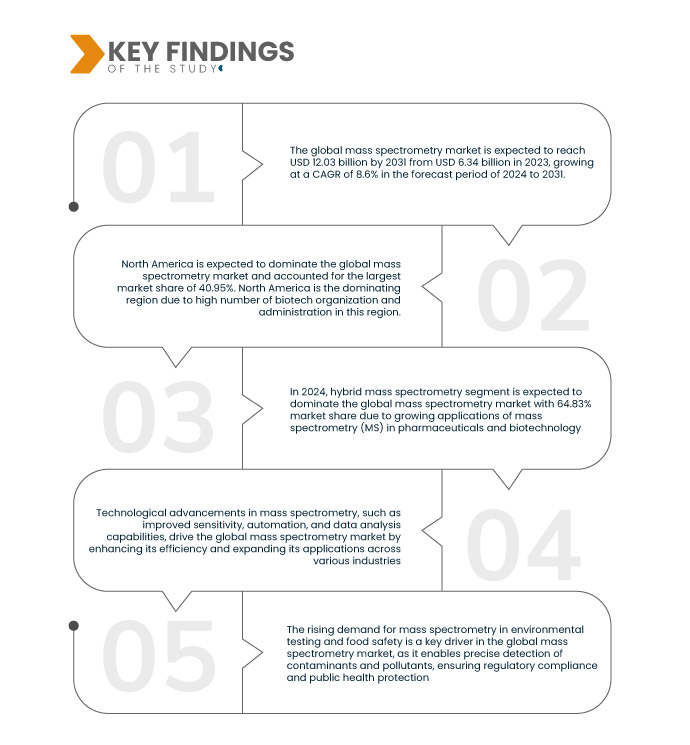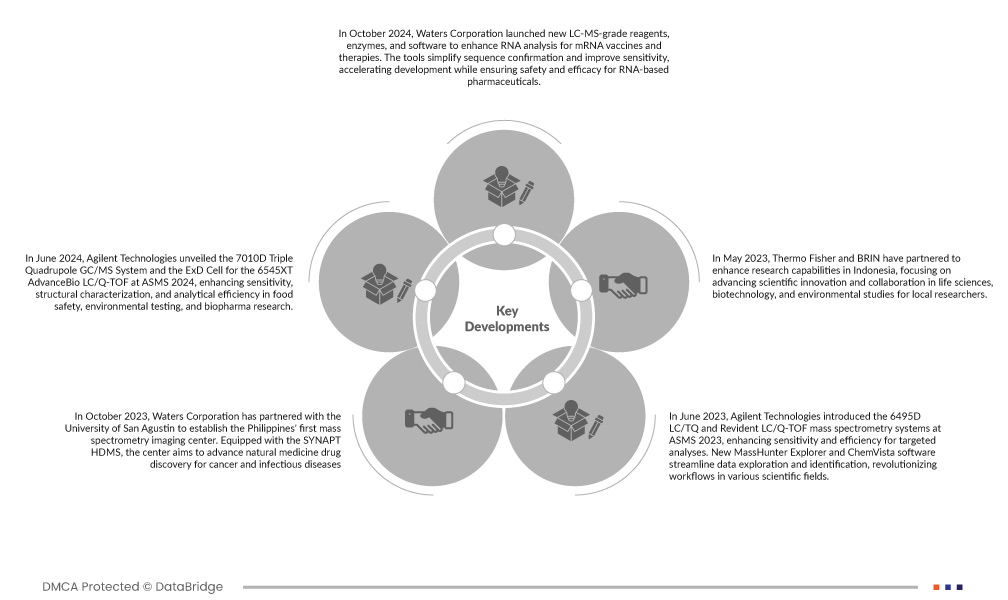Technological advancements in mass spectrometry have significantly propelled the growth of the global mass spectrometry market by enhancing the precision, speed, and range of applications in various industries. Innovations like the development of hybrid mass spectrometry systems, improved ionization techniques, and the integration of artificial intelligence (AI) and machine learning have broadened the scope of mass spectrometry in fields such as pharmaceuticals, biotechnology, environmental analysis, and food safety. These advancements allow for faster and more accurate detection of molecules, enabling researchers to perform complex analyses with higher sensitivity and reliability. Also, the miniaturization of mass spectrometry devices has facilitated the use of portable systems in point-of-care diagnostics and field testing, expanding their market reach. Continuous improvements in software and data analysis capabilities have also made the technology more accessible, enabling real-time data processing and automation, which reduces human error and enhances throughput in laboratories, further driving demand.
For instance,
- In August 2023, according to the article published in Academic Research, the technological advancements of mass spectrometry (MS) in omics technologies, emphasizing its impact on genomics, proteomics, metabolomics, and lipidomics. Key developments include high-resolution mass analyzers, such as Orbitrap and FT-ICR, which enhance sensitivity and accuracy in molecular analysis. Improved ionization techniques, like MALDI and electrospray ionization, facilitate the analysis of diverse biomolecules in their native states.
Advancements in mass spectrometry have significantly boosted its market by improving accuracy, speed, and versatility across multiple industries. Enhanced detection capabilities, portable systems, and smarter data processing have made the technology more accessible and efficient, expanding its use in research, diagnostics, and industrial applications, ultimately driving market growth.
Access Full Report: https://www.databridgemarketresearch.com/zh/reports/global-mass-spectrometry-market
Data Bridge Market Research analyzes that the Global Mass Spectrometry Market is expected to reach USD 12.03 billion by 2031 from USD 6.34 billion in 2023, growing with a CAGR of 8.6% in the forecast period of 2024 to 2031.
Key Findings of the Study
Report Scope and Market Segmentation
|
Report Metric
|
Details
|
|
Forecast Period
|
2024 to 2031
|
|
Base Year
|
2023
|
|
Historic Years
|
2022 (Customizable 2016-2021)
|
|
Quantitative Units
|
Revenue in USD Billion
|
|
Segments Covered
|
Technology (Hybrid Mass Spectrometry, Single Mass Spectrometry and Others), Modality (Benchtop and Standalone), Application (Life Science Research, Drug Discovery, Environmental Testing, Food Testing, Applied Industries, Clinical Diagnostics and Others), End User (Pharmaceutical Industry, Research and Academic Institutes, Food & Beverage Industry, Petrochemical Industry, Others), Distribution Channel (Direct Tenders, Retail Sales and others)
|
|
Countries Covered
|
U.S., Canada, Mexico, Germany, France, U.K., Italy, Spain, Russia, Netherland, Switzerland, Turkey, Rest of Europe, China, Japan, India, Australia, South Korea, Thailand, Indonesia, Malaysia, Singapore, Vietnam, Philippines, Rest of APAC, Brazil, Argentina, Rest of South America, Saudi Arabia, South Africa, Egypt, U.A.E., Israel, Rest of MEA
|
|
Market Players Covered
|
Thermo Fisher Scientific Inc. (U.S.), Shimadzu Corporation (Japan), Agilent Technologies Inc. (U.S.), Bruker (U.S.), Waters Coproration (U.S.), AMETEK Inc. (U.S.), Danaher Corporation (U.S.), Hiden Analytical (England), Hitachi Ltd. (japan), JEOL Ltd. (Japan), KORE Technology (U.K.), Leco Corporation (U.S.), PerkinElmer Inc. (U.S.), and Rigaku Holdings Corporation (Japan)
|
|
Data Points Covered in the Report
|
In addition to the insights on market scenarios such as market value, growth rate, segmentation, geographical coverage, and major players, the market reports curated by the Data Bridge Market Research also include in-depth expert analysis, patient epidemiology, pipeline analysis, and regulatory framework
|
Segment Analysis
Global mass spectrometry market is segmented into five notable segments based on technology, modality, application, end user, and distribution channel.
- On the basis of technology, the market is segmented into hybrid mass spectrometry, single mass spectrometry, and others
In 2024, the hybrid mass spectrometry segment is expected to dominate the market
In 2024, the hybrid mass spectrometry segment is expected to dominate the market with a market share of 64.83% due to growing healthcare needs.
- On the basis of modality, the market is segmented into benchtop and standalone
In 2024, the benchtop segment is expected to dominate the market
In 2024, the benchtop segment is expected to dominate the market with a market share of 72.74% because it is easy to relocate.
- On the basis of application, the market is segmented into life science research, drug discovery, environmental testing, food testing, applied industries, clinical diagnostics, others. In 2024, life science research segment is expected to dominate the market with a market share of 33.13%
- On the basis of distribution channel, the market is segmented into direct tenders, retail sales, and others . In 2024, direct tenders segment is expected to dominate the market with a market share of 59.72%
- On the basis of end user, the market is segmented into pharmaceutical industry, research and academic institutes, food & beverage industry, petrochemical industry, and others. In 2024, pharmaceutical industry segment is expected to dominate the market with a market share of 57.12%
Major Players
Data Bridge Market Research analyzes Thermo Fisher Scientific Inc. (U.S.), Shimadzu Corporation (Japan), Agilent Technologies Inc. (U.S.), Bruker (U.S.), Waters Coproration (U.S.), Danaher Corporation (U.S.) are the major companies operating in the Global Mass Spectrometry market.
Market Developments
- In October 2024, Waters Corporation launched new LC-MS-grade reagents, enzymes, and software to enhance RNA analysis for mRNA vaccines and therapies. The tools simplify sequence confirmation and improve sensitivity, accelerating development while ensuring safety and efficacy for RNA-based pharmaceuticals
- In June 2024, Agilent Technologies unveiled the 7010D Triple Quadrupole GC/MS System and the ExD Cell for the 6545XT AdvanceBio LC/Q-TOF at ASMS 2024, enhancing sensitivity, structural characterization, and analytical efficiency in food safety, environmental testing, and biopharma research
- In October 2023, Waters Corporation has partnered with the University of San Agustin to establish the Philippines' first mass spectrometry imaging center. Equipped with the SYNAPT HDMS, the center aims to advance natural medicine drug discovery for cancer and infectious diseases
- In June 2023, Agilent Technologies introduced the 6495D LC/TQ and Revident LC/Q-TOF mass spectrometry systems at ASMS 2023, enhancing sensitivity and efficiency for targeted analyses. New MassHunter Explorer and ChemVista software streamline data exploration and identification, revolutionizing workflows in various scientific fields
- In May 2023, Thermo Fisher and BRIN have partnered to enhance research capabilities in Indonesia, focusing on advancing scientific innovation and collaboration in life sciences, biotechnology, and environmental studies for local researchers
Regional Analysis
Geographically, the countries covered in the global mass spectrometry market report China, India, Australia, South Korea, Japan, Indonesia, Malaysia, Singapore, Thailand, Philippines, rest of Asia-Pacific, Brazil, Argentina, rest of South America, France, Germany, U.K., Italy, Hungary, Turkey, Ireland, Austria, Poland, Norway, rest of Europe, U.S., Canada, Mexico, South Africa, U.A.E., Egypt, Kuwait, and rest of Middle East and Africa.
As per Data Bridge Market Research analysis:
North America is expected to dominate be the fastest growing region in the global mass spectrometry market
North America is expected to dominate the market due to its advanced research infrastructure, significant investments in healthcare and life sciences, and high adoption of cutting-edge technologies like hybrid and tandem mass spectrometry. Strong support from government initiatives and regulatory agencies fosters innovation and drives market growth in the region.
Asia-Pacific is expected be the fastest growing region in the global mass spectrometry market
Asia-Pacific is expected to be the fastest growing due to rapid advancements in healthcare infrastructure and increased investments in research and development across the region.
For more detailed information about the Global Mass Spectrometry market report, click here – https://www.databridgemarketresearch.com/zh/reports/global-mass-spectrometry-market














